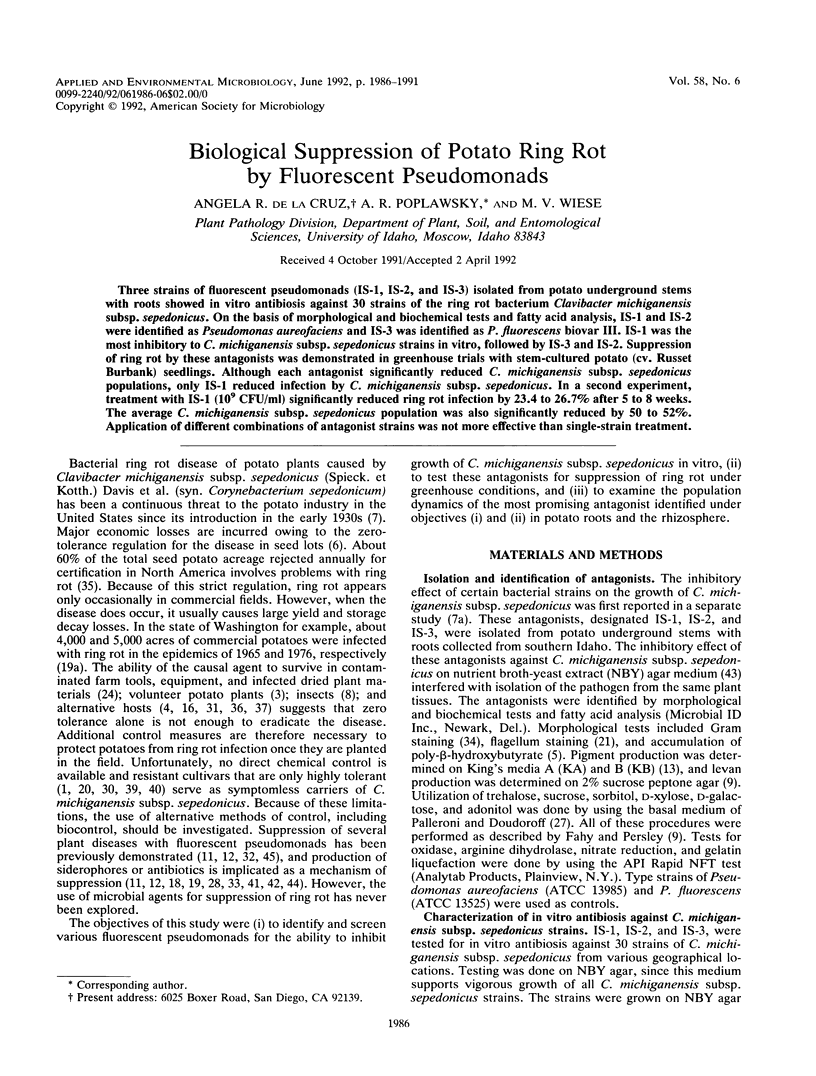Abstract
Three strains of fluorescent pseudomonads (IS-1, IS-2, and IS-3) isolated from potato underground stems with roots showed in vitro antibiosis against 30 strains of the ring rot bacterium Clavibacter michiganensis subsp. sepedonicus. On the basis of morphological and biochemical tests and fatty acid analysis, IS-1 and IS-2 were identified as Pseudomonas aureofaciens and IS-3 was identified as P. fluorescens biovar III. IS-1 was the most inhibitory to C. michiganensis subsp. sepedonicus strains in vitro, followed by IS-3 and IS-2. Suppression of ring rot by these antagonists was demonstrated in greenhouse trials with stem-cultured potato (cv. Russet Burbank) seedlings. Although each antagonist significantly reduced C. michiganensis subsp. sepedonicus populations, only IS-1 reduced infection by C. michiganensis subsp. sepedonicus. In a second experiment, treatment with IS-1 (10(9) CFU/ml) significantly reduced ring rot infection by 23.4 to 26.7% after 5 to 8 weeks. The average C. michiganensis subsp. sepedonicus population was also significantly reduced by 50 to 52%. Application of different combinations of antagonist strains was not more effective than single-strain treatment.
Full text
PDF





Images in this article
Selected References
These references are in PubMed. This may not be the complete list of references from this article.
- Burdon K. L. Fatty Material in Bacteria and Fungi Revealed by Staining Dried, Fixed Slide Preparations. J Bacteriol. 1946 Dec;52(6):665–678. doi: 10.1128/jb.52.6.665-678.1946. [DOI] [PMC free article] [PubMed] [Google Scholar]
- KING E. O., WARD M. K., RANEY D. E. Two simple media for the demonstration of pyocyanin and fluorescin. J Lab Clin Med. 1954 Aug;44(2):301–307. [PubMed] [Google Scholar]
- Leisinger T., Margraff R. Secondary metabolites of the fluorescent pseudomonads. Microbiol Rev. 1979 Sep;43(3):422–442. doi: 10.1128/mr.43.3.422-442.1979. [DOI] [PMC free article] [PubMed] [Google Scholar]
- Mayfield C. I., Inniss W. E. A rapid, simple method for staining bacterial flagella. Can J Microbiol. 1977 Sep;23(9):1311–1313. doi: 10.1139/m77-198. [DOI] [PubMed] [Google Scholar]
- Thomashow L. S., Weller D. M., Bonsall R. F., Pierson L. S. Production of the antibiotic phenazine-1-carboxylic Acid by fluorescent pseudomonas species in the rhizosphere of wheat. Appl Environ Microbiol. 1990 Apr;56(4):908–912. doi: 10.1128/aem.56.4.908-912.1990. [DOI] [PMC free article] [PubMed] [Google Scholar]
- Thomashow L. S., Weller D. M. Role of a phenazine antibiotic from Pseudomonas fluorescens in biological control of Gaeumannomyces graminis var. tritici. J Bacteriol. 1988 Aug;170(8):3499–3508. doi: 10.1128/jb.170.8.3499-3508.1988. [DOI] [PMC free article] [PubMed] [Google Scholar]
- Vidaver A. K. Synthetic and complex media for the rapid detection of fluorescence of phytopathogenic pseudomonads: effect of the carbon source. Appl Microbiol. 1967 Nov;15(6):1523–1524. doi: 10.1128/am.15.6.1523-1524.1967. [DOI] [PMC free article] [PubMed] [Google Scholar]



